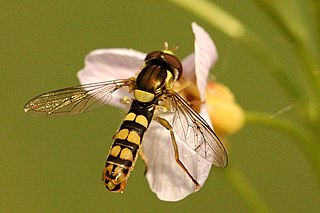
Eupeodes luniger is a common species of hoverfly.

Leucozona laternaria is a European species of hoverfly.

Sphaerophoria interrupta is a Palearctic species of hoverfly.

Sericomyia lappona, is a species of hoverfly. It is widespread throughout the Palearctic.

Microdon mutabilis, is a species of hoverfly. It is found in many parts of Britain and Europe. The distinctive almost slug-like larvae live in ants' nests. They are hemispherical in shape, heavily armoured and believed to prey on the eggs and larvae of a number of ant species, including Formica lemani, Formica fusca, Lasius niger and Myrmica ruginodis. It was described by Carl Linnaeus in his landmark 1758 10th edition of Systema Naturae.

Pipiza noctiluca is a species of Hoverfly, from the family Syrphidae, in the order Diptera.

Pipiza bimaculata is a species of hoverfly, from the family Syrphidae, in the order Diptera.

Pipiza luteitarsis is a species of Hoverfly, from the family Syrphidae, in the order Diptera.

Pipizella viduata is a species of Hoverfly, from the family Syrphidae, in the order Diptera.

Riponnensia splendens is a small metallic species of hoverfly. It is found in Europe.

Anasimyia lineata is a Palaearctic species of hoverfly.

Anasimyia transfuga is a Palearctic species of hoverfly.

Parhelophilus consimilis is a Palearctic hoverfly.
Heringia heringi is a European species of hoverfly.

Platycheirus ambiguus is a small widespread species of hoverfly found across the Palearctic from Ireland to Japan. A spring species found in flight in April and May, it visits spring-flowering trees and shrubs, e.g., Prunus spinosa in deciduous woodland and scrub.

Platycheirus melanopsis is a species of hoverfly. It is found from northern Europe across to eastern Siberia. The larva is described by Rotheray

Chrysotoxum festivum is a species of hoverfly.

Dasysyrphus pinastri is a species of hoverfly found in Europe.

Eumerus funeralis or lesser bulb fly is a species of Hoverfly, from the family Syrphidae, in the order Diptera. E. funeralis appears in Peck (1988) as a synonym of E. strigatus (Fallen), but was reinstated as the correct name for tuberculatus Rondani, sensu auctorum by Speight et al. (1998).

Xylota abiens is a European species of hoverfly.



















